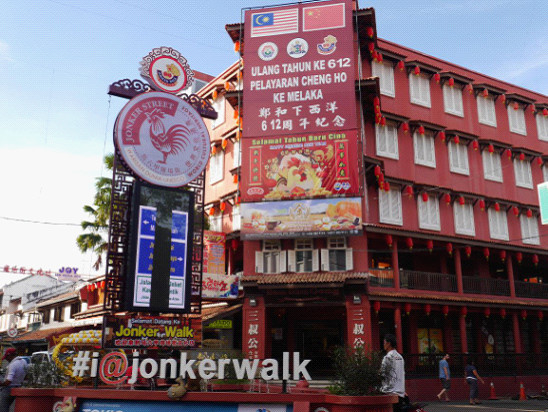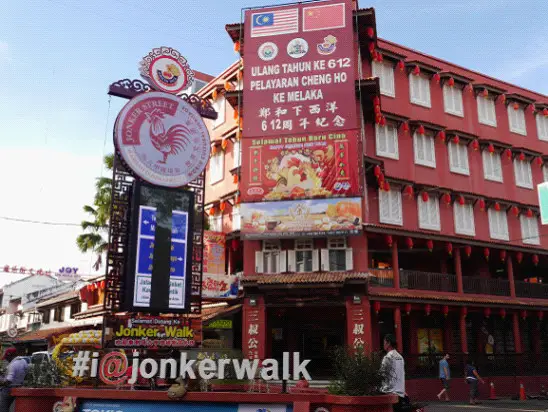By Zhang Zhiwen, Yu Yichun from People’s Daily

A banner “In commemoration of the 612th anniversary of Zheng He's voyages” is seen in the 300-year-old Jonker Street in Malacca's historic towns. The Jonker Street, the Chinatown street of Malacca, witnessed the frequent exchanges between China and Malaysia in history. (Photo by Yu Yichun from People’s Daily)
Malacca, a Malaysian city whose rise and decline was closely related to the Maritime Silk Road in history, has embraced hope to reinstate its prosperity thanks to the Belt and Road Initiative.
The rise of Malacca state whose capital city is Malacca city, was facilitated by the armada of a revered Chinese navigator Zheng He during the Ming Dynasty (1368-1644). Zheng’s fleet was stationed in Malacca on five of his seven maritime expeditions, according to Mao Lei, associated professor of History Department with Xiamen University.
At the same time, the King and diplomatic envoys of Malay dynasty of Malaccaconducted over 20 visits to the Ming government, said Chen Dasheng, head of the Cheng Ho Cultural Museum in Melaka City.
Six centuries later, Malaysia's participation in China's Belt and Road Initiative has built a new connectivity platform that enables Malacca to see the hope to restore its lost glory.
In 2014, China’s Xinyi Glass Holdings Limited, a major supplier in the industry, invested $200 million to build its first production base in Malacca. Before that, Malaysia had to spend $300 million on imported glass every year to meet its domestic demands.
The deal was then also the largest overseas investment for the coastal state in over a decade.
The glass factory started construction in 2015 and became operative at the end of 2016. Seeing the sound effect of cooperation, Xinyi invested another $200 million in the second phase to expand production. The second phase started construction on March 12 this year.
In only two years, Malaysia’s glass industry has undergone drastic changes. Relying on the most advanced manufacturing technique in China even in the world, Malaysia now has the confidence to call itself as an export base for the foreign market, which in turn will benefit China’s economy as well.
Melaka Gateway is another key Sino- Malaysian project in Malacca. Co-built by a Malaysian investment company and three Chinese companies, namely PowerChina International, Shenzhen Yantian Port Group and Rizhao Port Group, it is a mega project that includes deepwater wharf, tourism, residential and commercial use, estate development, and coastal industrial park.
“China has the world’s top-ranking technologies and working efficiency, and our cooperation with the Chinese enterprises will yield twice the result with half the effort,” according to Michelle Ong, the Malaysian head of the project and CEO of Malaysia's KAJ Development.
It was recorded that more than 84 languages were spoken in the state of Malacca in its 700-plus years of history, and Zheng He’s fleet had brought friendship and peace to the place, Michelle Ong said, adding that the Melaka Gateway will bring back the former glory of Malacca.
The Melaka Gateway, upon completion, will be a massive deep-sea port as well as a marina for yachts, according to Malaysia's minister of transport Liow Tiong Lai.
Malacca's port would focus on the supply and replenishment of passing vessels, indicating a bright prospect for Sino-Malaysian cooperation, which will drive the all round development of the country’s economy and tourism, the minister added.
The rise of Malacca state whose capital city is Malacca city, was facilitated by the armada of a revered Chinese navigator Zheng He during the Ming Dynasty (1368-1644). Zheng’s fleet was stationed in Malacca on five of his seven maritime expeditions, according to Mao Lei, associated professor of History Department with Xiamen University.
At the same time, the King and diplomatic envoys of Malay dynasty of Malaccaconducted over 20 visits to the Ming government, said Chen Dasheng, head of the Cheng Ho Cultural Museum in Melaka City.
Six centuries later, Malaysia's participation in China's Belt and Road Initiative has built a new connectivity platform that enables Malacca to see the hope to restore its lost glory.
In 2014, China’s Xinyi Glass Holdings Limited, a major supplier in the industry, invested $200 million to build its first production base in Malacca. Before that, Malaysia had to spend $300 million on imported glass every year to meet its domestic demands.
The deal was then also the largest overseas investment for the coastal state in over a decade.
The glass factory started construction in 2015 and became operative at the end of 2016. Seeing the sound effect of cooperation, Xinyi invested another $200 million in the second phase to expand production. The second phase started construction on March 12 this year.
In only two years, Malaysia’s glass industry has undergone drastic changes. Relying on the most advanced manufacturing technique in China even in the world, Malaysia now has the confidence to call itself as an export base for the foreign market, which in turn will benefit China’s economy as well.
Melaka Gateway is another key Sino- Malaysian project in Malacca. Co-built by a Malaysian investment company and three Chinese companies, namely PowerChina International, Shenzhen Yantian Port Group and Rizhao Port Group, it is a mega project that includes deepwater wharf, tourism, residential and commercial use, estate development, and coastal industrial park.
“China has the world’s top-ranking technologies and working efficiency, and our cooperation with the Chinese enterprises will yield twice the result with half the effort,” according to Michelle Ong, the Malaysian head of the project and CEO of Malaysia's KAJ Development.
It was recorded that more than 84 languages were spoken in the state of Malacca in its 700-plus years of history, and Zheng He’s fleet had brought friendship and peace to the place, Michelle Ong said, adding that the Melaka Gateway will bring back the former glory of Malacca.
The Melaka Gateway, upon completion, will be a massive deep-sea port as well as a marina for yachts, according to Malaysia's minister of transport Liow Tiong Lai.
Malacca's port would focus on the supply and replenishment of passing vessels, indicating a bright prospect for Sino-Malaysian cooperation, which will drive the all round development of the country’s economy and tourism, the minister added.
 Menu
Menu
 Belt and Road Initiative casts light to Malacca’s rejuvenation
Belt and Road Initiative casts light to Malacca’s rejuvenation
















